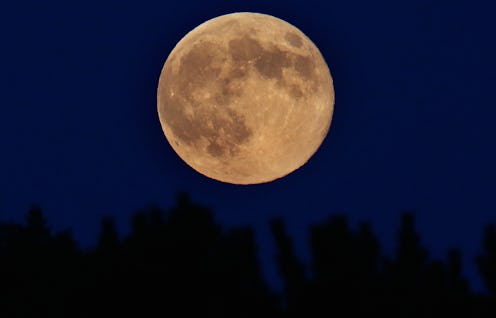
If you're dreading the beginning of Mercury Retrograde Dec. 3, you can counteract the smallest planet's bad mojo by setting your intentions under December's supermoon, which is happening the same day. But some people will want to check out the moon just because it's, well, huge and gorgeous, and are frantically wondering when is the best time to see the December supermoon. The only supermoon of 2017 — known as the Full Cold Moon — takes place Dec. 3. According to The Old Farmer's Almanac, supermoons appear up to 14 percent larger, and up to 30 percent brighter, than regular full moons.
The Full Cold Supermoon will be closest to Earth in the early morning hours of Dec. 4. However, that's not necessarily the best time to see it. National Geographic reported that the best time to view this bright beauty is right after sunset on Dec. 3 when the Full Cold Moon rises. You can even find the exact time for optimal supermoon viewing in your state.
Native Americans dubbed December's full moon the Full Cold Moon because it signals the beginning of winter when cold weather fastens its grip on much of the country until spring. Other native American tribes called it the Long Nights Moon because it occurs close to the winter solstice, the shortest night of the year, The Old Farmer's Almanac explained. Additionally, some folktales note that if there is a snow storm during the Cold Full Moon, the snow will stop by the time the moon rises, which is good news for those who want to view the supermoon.
Viewing The Dec. 3 Full Cold Supermoon
National Geographic reported that the Dec. 3 supermoon will appear 7 percent larger and 16 percent brighter than a normal December full moon. While the Full Cold Moon is technically the fourth supermoon of 2017, it's the only one you've been able to see with the naked eye, making it the only visible supermoon of 2017. "That’s because the other three supermoons of 2017 coincided with new moons, when the lunar disk shows a totally darkened face," Andrew Fazekas wrote for National Geographic.
So, why is the moonrise the best time to view the supermoon? If you've ever been driving and been caught off guard by a giant rising moon right after sunset, then you know that this is when a full moon looks the most dramatic. But, why does the moon look so much larger, and yet so much further away, while it's ascending in the sky versus when it's directly overhead? According to Nadia Drake for National Geographic, while the moon seems to grow smaller and closer as it rises higher into the sky, it's actually not changing size, nor is it any closer to Earth than it was during its rise.
This phenomenon is called moon illusion, and scientists still can't agree on what makes the moon appear larger and more distant when viewed on the horizon versus when it's high in the sky, though it might have something to do with how our minds perceive the moon in relation to the objects around it.
The above picture was taken from a west-facing sixth-floor window in my old apartment. While I lived here, I witnessed some of the most incredible moon rises I've ever seen in my life, and each month I was completely moonstruck while watching these otherworldly full moon ascensions. However, in my new house, the moon does not seem anywhere near as big or bright even though it's the exact same moon. The only thing that's changed is my view and perception of it. From my old view, when the moon was high in the sky outside of my window, it appeared that it was close enough that I could throw a lasso around it and pull it right into my apartment. Moon illusion indeed.
"One reason why the horizon might appear more distant than the sky overhead is that our brains perceive the shape of 'space' as a gently flattened dome rather than a perfectly round sphere," Drake wrote. "That means we judge celestial objects that are overhead to be closer than celestial objects on the horizon."
While many thing about the moon are still a mystery, one thing everyone can agree on is that the supermoon is an awe-inspiring event. However, if you miss the Dec. 3 supermoon because you're mired in Mercury Retrograde drama, don't beat yourself up.While there is only one supermoon in 2017, there are two supermoons in January 2018, The Old Farmer's Almanac reported. The first is Jan. 2 and the other is Jan. 31, so there is plenty of great supermoon viewing in your future.